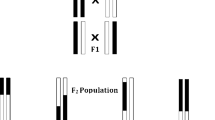“Success in application of genetic knowledge to the breeding process is determined by the development of rapid tests to increase the genotype assessment rate for necessary productivity traits”
(M.E. Lobashev, B.L. Astaurov, and N.P. Dubinin, “Modern Genetics in Solving Breeding Problems,” “Genetika” (Moscow), no. 10, p. 22 (1966))
Abstract
During the period from 1984 to 2014, our scientific school (consisting of 35 candidates and 12 doctors of science by 2018) developed a new theory of the ecological genetic organization of quantitative traits (TEGOQT). The theory is based on the discovery of a new epigenetic phenomenon, a change in the gene product profiles under a quantitative trait with the change of limiting environmental factor. A total of 24 important results and 10 techniques capable of eliminating the “bottlenecks” of traditional yield, increasing breeding technologies originated from the theory. TEGOQT gave rise to 16 innovative technologies for the construction of cutting-edge crop varieties characterized by high yield and product quality, which have been experimentally tested on many crops, and were tens and hundreds of times more effective than traditional yield increasing breeding technologies. This study describes the first among these 16 technologies, which is an important group of technologies for rapid (without alternation of generations) identification of the most productive genotypes during selection in segregating and wild populations. This group of technologies is based on the TEGOQT consequences, namely, the principle of background traits and the principle of “orthogonal” identification of maximum positive contributions to the yield of seven open genetic physiological systems (GPSs), including attraction; microdistribution of macronutrients between the spike grain and chaff; adaptability (drought, heat, frost, cold, salt tolerance, etc.); horizontal immunity; “paying” with dry plant biomass for low doses of soil nutrition (N, P, K); tolerance to phytocoenosis overcrowding; and genetic variability of the duration of ontogenetic stages.
Similar content being viewed by others
REFERENCES
J. L. Brewbaker, Agricultural Genetics (Prentice-Hall, New Jersey, 1965).
Yu. N. Ivanov Thoughts on Science and Life, 4th ed. (Svin’in and Synov’ya, Novosibirsk, 2011) [in Russian].
L. A. Lutova, “Modern technologies in plant biology,” in Proc. All-Russian School of Young Scientists in Environmental Genetics (Krasnodar, 2012), pp. 82–100 [in Russian].
V. A. Dragavtsev, R. A. Tsil’ke, B. G. Reiter, V. A. Vorob’ev, A. G. Dubrovskaya, N. I. Korobeinikov, V. V. Novokhatin, V. P. Maksimenko, A. G. Babakishiev, V. G. Ilyushchenko, N. A. Kalashnik, Yu. P. Zuikov, and A. M. Fedotov, The Genetics of Productivity Traits of Spring Wheats in Western Siberia (Nauka, Novosibirsk, 1984) [in Russian].
V. A. Dragavtsev, P. P. Litun, N. M. Shkel’, and N. N. Nechiporenko, Dokl. Akad. Nauk SSSR 274 (3), 720 (1984).
V. A. Dragavtsev, Biosfera 4 (3), 251 (2012).
Encyclopedia “Basic Life Sciences” (Plenum, New York, 1977), Vol. 8, pp. 233–240.
V. I. Glazko and G. V. Glazko, Explanatory Dictionary of Terms on General and Molecular Biology, General and Applied Genetics, Selection, DNA Technology and Bioinformatics (Akademkniga–Medkniga, Moscow, 2008), Vol. 2 [in Russian].
N. M. Makrushin, V. A. Dragavtsev, Yu. V. Plugatar’, S. I. Maletskii, A. M. Mal’ko, E. M. Makrushina, and R. Yu. Shabanov, Explanatory Dictionary of Innovative Issues of Plant Breeding, Seed Production and Reproduction (Russian-English) (Diaipi, Simferopol, 2017) [in Russian].
Brief Dictionary of Forest Genetics (The Principle of Background Traits by V. A. Dragavtsev) (Nauka, Krasnoyarsk, 2015) [in Russian].
N. P. Krenke, Phenogenetic Variability (Timiryazev Biol. Inst., Moscow, 1933–1935), Vol. 1 [in Russian].
N. A. Plokhinskii, Heritability (Nauka, Novosibirsk, 1964) [in Russian].
W. Williams, Genetic Principles and Plant Breeding (Blackwell Sci., Oxford, 1964).
Z. S. Nikoro, Z. N. Kharitonova, and N. F. Reshetnikova, Different Ways of Determining the Breeding Value of Animals (Kolos, Moscow, 1968) [in Russian].
P. F. Rokitskii, Introduction to Statistical Genetics (Vysheishaya Shkola, Minsk, 1974) [in Russian].
V. K. Savchenko, Genetic Analysis in Network Test Crosses (Nauka i Tekhnika, Minsk, 1984) [in Russian].
P. P. Litun, “Resolution of modern selection schemes,” in Proc. 4th All-Union Congress of the All-Union Society of Geneticists and Breeders Named after N. I. Vavilova, Vol. 2: Plant Genetics (Kishinev, 1982), pp. 89–91 [in Russian].
V. A. Dragavtsev and V. M. Ostrikova, Genetika, No. 8 (4), 33 (1972).
V. A. Dragavtsev, I. B. Pogozhev, and T. A. Sokolova, Quantitative Estimates of the Genotypic Values of Plant Traits, Taking into Account the Distribution of Ecological Deviations in Phenotypes. Ecosystem Models and Methods for Determining Their Parameters (Comput. Center Sib. Branch Acad. Sci. USSR, Novosibirsk, 1981), pp. 190–196 [in Russian].
V. A. Dragavtsev, Doctoral Dissertation in Biology (Inst. Gen. Genetics, Moscow, 1984).
A. Yu. D’yakov and V. A. Dragavtsev, Multidirectional Shifts of the Quantitative Trait of an Individual Organism under the Influence of Genetic and Environmental Causes in Two-Dimensional Systems of Attribute Coordinates. Ecological Genetic Screening of the Gene Pool and Methods for Constructing Varieties of Agricultural Plants in Terms of Yield, Resistance and Quality (VIR, St. Petersburg, 1998), pp. 23–40 [in Russian].
ACKNOWLEDGMENTS
The author is grateful to the Agrophysical Research Institute, St. Petersburg, Ecological Commission of the Legislative Assembly of Leningrad Oblast, and the MIR Group of Companies for support of the research.
Funding
This study was supported by the Russian Foundation for Basic Research, grants nos. 07-04-01714, 13-01-96519, and 16-04-00199.
Author information
Authors and Affiliations
Corresponding author
Ethics declarations
The author declares that he has no conflicts of interest.
Rights and permissions
About this article
Cite this article
Dragavtsev, V.A. Design of Domestic Physical Instruments for Rapid (without Alternation of Generations) Genotype Identification during Selection in Segregating and Wild Plant Populations. Tech. Phys. 65, 1558–1562 (2020). https://doi.org/10.1134/S1063784220100060
Received:
Revised:
Accepted:
Published:
Issue Date:
DOI: https://doi.org/10.1134/S1063784220100060




